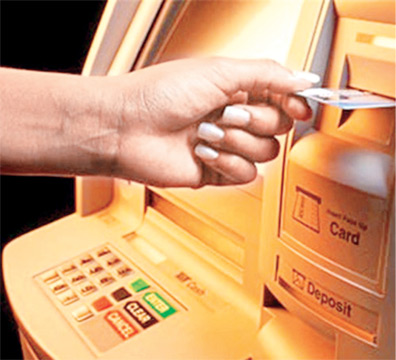Role of ATMs in enhancing business efficiency
by Tharindu Weerasinghe
Almost all of us use ATMs (Automated Teller Machines) to withdraw
money from our bank accounts. It is the most convenient way to withdraw
money as otherwise we would have to wait in queues in banks to get it
done. ATMs can be used not only to withdraw money but also check account
balances and many other operations. The more sophisticated machines can
be used to deposit cash and cheques.
How an ATM works
 Basic Information: An Automated Teller Machine is an electronic
device that is connected to the financial institute's network via a
telephone connection which allows the customers to make transactions. Basic Information: An Automated Teller Machine is an electronic
device that is connected to the financial institute's network via a
telephone connection which allows the customers to make transactions.
You input your ATM card, then you enter the PIN according to the
provided instructions and then proceed. An ATM machine has a two-factor
authentication that means you need to enter your plastic card (with a
magnetic strip or an inbuilt chip) and also the PIN. (Another famous two
factor authentication scheme is user name and passwords which you see in
many software applications).
Therefore, a basic ATM has two input devices (the card reader and
keyboard). But some modern machines may have a slot to insert cash or
cheques; then there will be three input devices.
It has four output devices as well. They are the display screen,
speaker, receipt printer and speaker.
The card reader reads the information stored on the magnetic strip on
the back of an ATM card.
The host computer uses this information to route the transaction to
the relevant bank. An ATM card can be seen in several formats such as
debit, credit and affinity. Anyhow they belong to three major categories
such as Visa, Master and Amex. An ATM card contains the unique card
number and some security information.
The ATM machine is connected to a host computer placed close to the
ATM machine. The computer is connected to the Bank's computer. In a
nutshell the ATM machine is connected to the bank network via these
computers.
What happens when you request a cash withdrawal?
· First you need to enter the card and PIN. Then the ATM forwards
this information to the computer (host processor) nearby, which routes
the request to the cardholder's bank or the institution that issued the
card. The bank needs to verify the information.
· If the customer wishes to withdraw cash (the request is a
withdrawal), then the host processor allows an electronic fund transfer
from the customer's bank account to the host processor's account.
· Once the funds are transferred to the host processor's bank
account, the processor sends an approval code to the ATM authorising the
machine to dispense the cash.
Inside the machine
An ATM consists of a CPU (to control the user interface and
transaction devices), magnetic and/or chip card reader (to identify the
customer), PIN pad (similar in layout to a touch tone or calculator
keypad), often manufactured as part of a secure enclosure, Secure
crypto-processor, generally within a secure enclosure, Display (used by
the customer for performing the transaction), Function key buttons
(usually close to the display) or a Touchscreen (used to select the
various aspects of the transaction), Record Printer (to provide the
customer with a record of their transaction), Vault (to store the parts
of the machinery needing restricted access), Housing (for aesthetics and
to attach signage).
Software: ATM machines typically get the help of operating systems
such as OS/2, RMX, Linux and Windows based operating systems to
function. Due to standardisation most of the ATMs use the XSF
(Extensions for Financial Services) platform.
This provides a common API or client server architecture for
accessing and manipulating the various devices of an ATM regardless of
the manufacturer.
Notable ATM software that operates on XFS platforms:
Triton PRISM, Diebold Agilis, CR2 BankWorld, KAL Kalignite, NCR
Corporation Aptra Edge, Phoenix Interactive VISTAatm, Wincor Nixdorf
Protopas.
Security mechanism:
There is a two factor authentication mechanism. The ATM card and PIN.
Both are compatible to each other. The PIN will be encrypted by the
special cryptographic processors placed in EPP (Encryption PIN Pad).
Using a cryptographic algorithm, the EPP performs a variety of
operations, including DES (Data Encryption Standard), Triple DES and MAC
(Message Authentication Code). This encrypted PIN will be sent to the
host computer together with the card number for authentication. |

